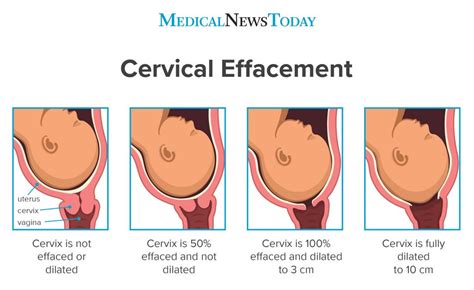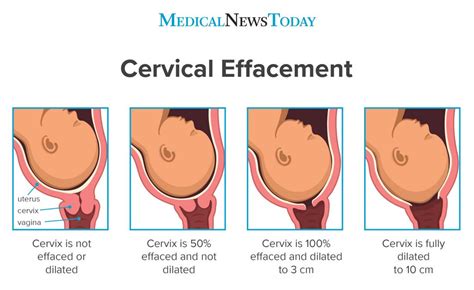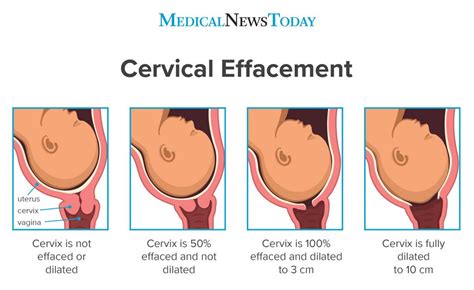Intro
Discover 5 key facts about effaced cervix, including cervical effacement, labor signs, and pregnancy complications, to understand this crucial pregnancy stage and its relation to cervical dilation and childbirth.
The term "effaced cervix" is often heard in the context of pregnancy, particularly in the later stages. It refers to the process by which the cervix, the lower part of the uterus, prepares for childbirth by thinning out and becoming shorter. This process is a crucial part of labor preparation and is closely monitored by healthcare providers to assess the progression towards delivery. Understanding the effacement of the cervix can provide valuable insights into the body's natural processes during pregnancy and help expectant mothers navigate the final stages of their pregnancy journey.
For many women, the concept of an effaced cervix might seem mysterious or even intimidating, especially if they are experiencing it for the first time. However, it is a natural and necessary step towards giving birth. As the body prepares for labor, the cervix undergoes significant changes, including effacement, which is measured in percentages, indicating how much the cervix has thinned. This measurement, along with dilation, helps healthcare providers assess the stage of labor and make informed decisions about the care and support needed during this critical period.
The process of cervical effacement is closely linked to the hormonal changes and physical pressures that occur in the later stages of pregnancy. As the uterus contracts and the baby moves down into the birth canal, the cervix begins to efface and dilate. This process can start weeks before actual labor begins, especially in women who have had previous pregnancies. Understanding these changes and what they mean for the progression of labor can help expectant mothers feel more in control and prepared for the birth of their baby.
What is Cervical Effacement?

How is Cervical Effacement Measured?
Cervical effacement is measured through a vaginal examination by a healthcare provider. During this examination, the provider assesses the thickness and length of the cervix, comparing it to its original state. The measurement is then expressed as a percentage, indicating the degree of effacement. For example, if the cervix is 50% effaced, it means that it has thinned by half. This measurement, along with the measurement of cervical dilation, provides a comprehensive picture of labor progression.Benefits of Understanding Cervical Effacement

Factors Influencing Cervical Effacement
Several factors can influence the rate and extent of cervical effacement. These include the woman's overall health, the presence of any pregnancy complications, and whether she has had previous pregnancies. Women who have had previous vaginal deliveries may experience faster effacement and dilation due to the body's previous experience with labor. Additionally, the position of the baby and the effectiveness of uterine contractions can also impact the effacement process.Signs and Symptoms of Cervical Effacement

Practical Tips for Managing Cervical Effacement
For women experiencing cervical effacement, there are several practical tips to manage the process comfortably. These include staying hydrated, practicing relaxation techniques to manage pain and anxiety, and maintaining a healthy diet to support the body's energy needs. Engaging in light physical activity, such as walking, can also help stimulate the labor process. It's essential to follow the advice of healthcare providers and attend regular prenatal check-ups to monitor the progression of labor and address any concerns.Complications Associated with Cervical Effacement

Role of Healthcare Providers in Monitoring Cervical Effacement
Healthcare providers play a crucial role in monitoring cervical effacement and supporting expectant mothers through the labor process. Through regular prenatal check-ups, providers can assess the progression of labor, identify any potential complications early, and offer personalized advice and care. They can also provide emotional support and reassurance, helping to alleviate anxiety and fear associated with the labor process.Emotional and Psychological Aspects of Cervical Effacement

Support Systems for Expectant Mothers
Building a strong support system is vital for expectant mothers experiencing cervical effacement and preparing for labor. This can include attending prenatal classes to learn about labor and delivery, joining support groups to connect with other expectant mothers, and maintaining open communication with healthcare providers. Having a birth plan in place, which outlines preferences for labor and delivery, can also help expectant mothers feel more in control and prepared for the birth experience.Conclusion and Next Steps

We invite you to share your thoughts and experiences with cervical effacement and labor. Your insights can help other expectant mothers feel more informed and supported as they prepare for childbirth. Please comment below with your questions, stories, or advice, and let's build a community of support and understanding around this significant aspect of pregnancy and childbirth.
What is the normal range for cervical effacement during labor?
+Cervical effacement is measured in percentages, with 0% indicating no effacement and 100% indicating complete effacement. A normal range for cervical effacement during labor can vary, but typically, it progresses from 0% to 100% as labor advances.
Can cervical effacement start before labor begins?
+Yes, cervical effacement can start weeks before actual labor begins, especially in women who have had previous pregnancies. This is a natural process as the body prepares for childbirth.
How can I manage discomfort during cervical effacement?
+Managing discomfort during cervical effacement involves staying hydrated, practicing relaxation techniques such as deep breathing or meditation, and maintaining a healthy diet. Light physical activity, like walking, can also help stimulate the labor process.
